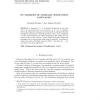Free Online Productivity Tools
i2Speak
i2Symbol
i2OCR
iTex2Img
iWeb2Print
iWeb2Shot
i2Type
iPdf2Split
iPdf2Merge
i2Bopomofo
i2Arabic
i2Style
i2Image
i2PDF
iLatex2Rtf
Sci2ools
ITA
2008
2008
On Varieties of Literally Idempotent Languages
A language L A is literally idempotent in case that ua2 v L if and only if uav L, for each u, v A , a A. Varieties of literally idempotent languages result naturally by taking all literally idempotent languages in a classical (positive) variety or by considering a certain closure operator on classes of languages. We initiate the systematic study of such varieties. Various classes of literally idempotent languages can be characterized using syntactic methods. A starting example is the class of all finite unions of B 1 B 2 . . . B k where B1, . . . , Bk are subsets of a given alphabet A. 1991 Mathematics Subject Classification. 68Q45.
| Added | 12 Dec 2010 |
| Updated | 12 Dec 2010 |
| Type | Journal |
| Year | 2008 |
| Where | ITA |
| Authors | Ondrej Klíma, Libor Polák |
Comments (0)

